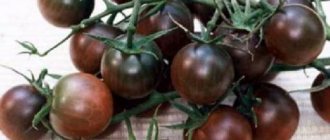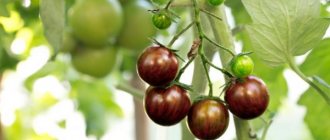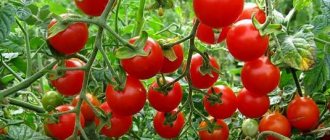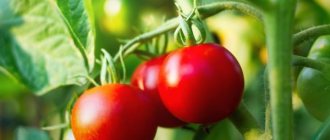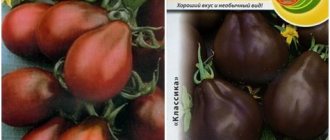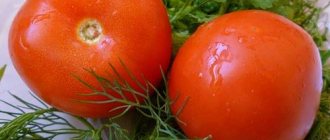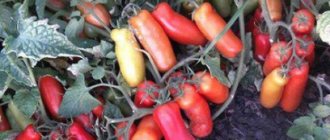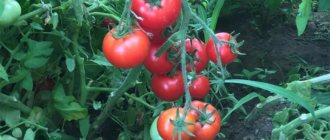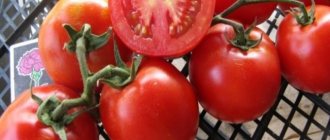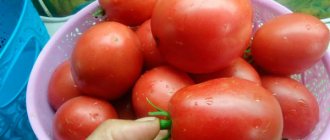The Black Gourmet tomato is a new variety on the Russian market, but it has already become a favorite of many gardeners. It is preferred due to its excellent sweet taste, unusual color and high content of nutrients.
| Height | Landing location | Ripening time | Fruit color | Fruit size | Origin | Fruit shape |
| Tall | Greenhouse | Mid-season | Black | Average | Variety | Round |
Description and characteristics of the variety
Tomato Black Gourmet from “Vkusnoteka” is an indeterminate bush about 180 cm – 2 m high. The inflorescence type is simple. Tomatoes ripen in bunches of ten in each. The size is average, the weight of the fruit is 80-120 g. The skin has a dark red, red-brown, burgundy or purple hue, and the flesh is dark, almost black, with green pulp. There are 4-6 seed chambers, the seeds are large. The taste of the pulp is very sweet and juicy.
Tomatoes are high in beneficial anthocyanins, which give them their dark color. They also contain a lot of fiber, carotenoids and B vitamins, about 1% vegetable protein and some choline. Ascorbic and folic acids approximately 45 mg/100 g.
Universal use - for all kinds of preparations, salads, decorating dishes and adding to vegetable cuts, soups, stews, as well as for processing into tomato products.
Origin of the variety
The Black Gourmet tomato will be included in the State Register of the Russian Federation in 2015. The variety was created by Russian specialists, breeders from. The result was obtained through long-term selection and crossing of samples of different varieties; the resulting tomato was not genetically modified.
Landing region
The originator advises cultivating the variety in greenhouses and various shelters in almost all regions. In the south, you can try to plant it in open ground, but this is risky for the harvest.
Ripening time
Tomatoes ripen in an average period - approximately 110-120 days from the moment of germination. In the south, in greenhouses, bushes can grow and bear fruit all year round.
How to grow tomatoes
After planting in the ground, the plants will need proper care. This section contains the basic rules and recommendations for growing Lakomka tomatoes in open and protected ground.
Landing
It is recommended to plant the black Gourmand tomato in a greenhouse when the temperature reaches at least +20°C.
During the period of growing seedlings, the stems have time to acquire several leaves. Before planting in the soil, the lower leaves should be carefully removed. On one square m. of land there should be approximately six to seven plant bushes.
So, how to plant a tomato correctly:
- make a hole in fertile soil;
- water the recess with a solution of potassium permanganate (a 1% solution is also suitable);
- carefully remove the seedlings;
- without damaging the root system, we plant it in the ground;
- sprinkle with earth;
- lightly moisten the soil.
Important ! If the seedlings were grown in peat pots, then plant the bush in the ground along with the pot.
Care
Tomatoes need pinching. Let us repeat that the first time it is carried out even before planting in the ground. Then the plant is pruned about once every ten days. If one of your bushes does not take root, your stepson can completely replace it.
The intensity of watering depends on the age of the plant. As soon as you plant it in the ground, the first watering should be plentiful, but then gradually reduce it. The minimum is during the period of fruit ripening. Here it is better to allow the soil to temporarily dry out than to over-wet it. This will affect the taste of the tomatoes. We remember that when watering, you should not allow water to get on the stem and leaves.
Loosening must be done after watering and rain. The bush is loosened carefully, retreating 5 cm from the stem. Weed regularly, otherwise you won’t be able to enjoy the large fruits.
The bush is tall, so about 20 days after planting in the ground, it needs to be tied up .
As for fertilizers, the variety has a positive attitude towards them, especially humic fertilizers. They can be used at any stage of fetal growth and maturation, but not more often than once every ten days.
Features of cultivation and possible difficulties
According to reviews from beginners and experienced gardeners, there are no particular difficulties in growing tomatoes.
What is important to pay attention to:
- Watering should be moderate. Excess moisture will lead to rotting tomatoes, sour taste and disease of the fruit.
- You cannot plant seedlings in the ground if the air temperature fluctuates frequently.
- A week before planting seedlings in the ground, harden the seedlings . This is done simply: we take the container with the seedlings out onto the balcony. The first hardening procedure lasts no more than five minutes. Then you can increase the duration to several hours. Hardening can only be done during the daytime.
- Keep a close eye on leaf shadows from neighboring plants. The black gourmet does not like this, so its own leaves are quite rare.
Diseases and pests
Late blight is one of the most common diseases. All work will go down the drain if the plant overcomes this fungal disease. The main reason is temperature fluctuations, improper watering and frequent weather changes. These are simply ideal conditions for the development of late blight.
The first symptom of late blight is blackened leaves. If this happens, it means that the fruit itself will soon turn black. Don't try to cure the bush. It must be removed and thrown away immediately. Otherwise, the infection will spread to neighboring bushes.
Is it possible to prevent the disease? You can: whey is the enemy of fungal bacteria. Spraying is performed once a week. In addition, specialized stores offer summer residents ready-made products to combat the disease. For example, "Late blight".
Brown spot is another fungal disease. Most often, greenhouse tomatoes are susceptible to it. The disease starts from the lower leaves. Therefore, inspect them regularly. The front side of the leaf is covered with yellow spots, and the reverse side is covered with a whitish coating. Leaves should be removed as quickly as possible. Copper-containing drugs are used to treat the disease.
Lack of moisture and low air temperature cause a disease such as powdery mildew. It is dangerous because it can quickly destroy the entire crop. It is impossible not to notice the manifestation of the disease. The leaves turn white and the stem also becomes covered with a white coating. The fruits themselves are not subject to plaque. The diseased plant is removed.
Spraying with special means is used as preventive measures. “Topaz” is one of the best and most recommended.
Features of the view
Characteristics and description of the variety:
| Tomato Gourmand | |
| general characteristics | Mid-season |
| Maturation period | 80-90 days after germination |
| Keeping quality (safety in storage) | Low |
| Purpose | Salad, canning (for processing into juices and sauces) |
| Fruit weight | 100-120g |
| Number of fruits per cluster | 4-5 |
| Disease resistance | High |
- Tomato Lakomka is a variety of Russian breeders, included in the state register in 2003. Designed for cultivation in open and protected ground.
- The plant is determinate, 50-60 cm high. The bush is compact, medium leafy, does not require pinching. With a bountiful harvest, it needs gartering of the brushes and trunk. The first tassels are tied above the 8th sheet, the next ones every 2 sheets.
- The variety is early ripening. The first ripe tomatoes appear 80-90 days after germination.
- The fruits are round, with smooth and thin skin, tender pulp. Sweet to taste, with a pronounced tomato aroma. The color of an unripe tomato is green with a bright spot at the stalk; when ripe, the fruit acquires a rich crimson hue.
- Tomatoes for salad purposes, weighing 100-120 g. Seed chambers 3-4. Perfect for fresh consumption and canning. They tolerate transportation well and are stored for up to 14 days in a cool place.
- The yield is high: up to 7 kg of fruit can be collected from one square meter. The tomatoes ripen together.
- Resistant to drought, blossom end rot, produces ovaries even under unfavorable conditions.
The pulp of the fruit is fleshy and juicy, the taste is excellent. Photo: eda-land.ru
Growing seedlings
The key to a good harvest is high-quality seedlings. Growing seedlings is not difficult if you follow certain rules.
- Seed preparation. Tomato seeds purchased from a specialty store are ready for planting. Those that you collected yourself require pre-processing and testing for germination. You can check the seeds using a saline solution. Dissolve one teaspoon of salt in a glass of warm water and soak the seeds. After 10 - 15 minutes, stir and remove all floating seeds - only those remaining at the bottom are suitable for planting. Seeds are checked for germination immediately before planting. The saline solution is washed off under running water.
- Sowing. Seeds can be sown dry or pre-soaked for 20 - 24 hours. They are sown in boxes or two seeds are planted in peat pots. Sowing depth is 1.5 cm. Containers for speedy germination are placed in a warm place and covered with glass (or film).
- Temperature. For seed germination, the temperature in the room is maintained at no lower than + 25. After the appearance of “hooks”, to stimulate the speedy emergence of seedlings, the temperature during the day is lowered by 5 degrees, at night - +16, +18 degrees.
- Lighting. In order for the seedlings to sprout smoothly and not stretch, additional lighting will be required for 12 to 14 hours.
- Caring for seedlings. After two true leaves appear on the seedlings, pick. Plants are planted in separate pots or special containers. The earth is periodically loosened. Water moderately.
Disease Control
The Gourmand tomato is practically not susceptible to most diseases. However, with improper care, some of them may appear. It's better to know about this in advance to prevent this from happening:
- Blackleg is a seedling disease that most often appears during heavy watering. If this happens, water the plant with a weak solution of potassium permanganate.
- Altenaria blight is a leaf disease that affects the leaves with dry spots; if timely treatment is not carried out, subsequent damage to the fruit occurs with black depressed formations. To combat this scourge, ready-made products are produced.
- Late blight is brown rot throughout the plant. As a rule, the cause of this disease is also excessive watering. An effective way to combat late blight is to treat tomatoes with a weak solution of boric acid. After two weeks, the procedure should be repeated.
Soil for planting
Vigorous tomatoes place high demands on soil fertility. Since this tomato has significant growth energy, a large supply of biomass and high yield, it needs to create conditions with highly fertile soil. Care should be taken to ensure that the soil in the greenhouse is fresh and free from pest larvae and pathogens.
To disinfect the soil, it can be spilled with a solution of potassium permanganate (potassium permanganate) or treated with steam.
The soil should contain fertile forest soil, peat and ordinary soil in a ratio of 2:1:3. For a light mechanical composition and good water permeability, sawdust or coarse sand can be added to the mixture. In addition, the ready-made mixture is filled with complex mineral fertilizer, for example, Nitroammofoska or Azofoska - this will be the main fertilizer.
